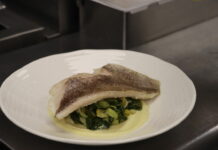 It was Mrs. Tawes who reminded me about Lady Baltimore Cake, the white cake with white frosting and a fruit and nut filling that shares the name of our fair city. She mentions it in the introduction to “My Favorite Maryland Recipes,” published in 1964 while she was still Maryland’s first lady (her husband was Gov. J. Millard Tawes), where she gently boasts about the “delicacies that carried their fame beyond our state’s borders”: Maryland fried chicken, Maryland beaten biscuits, Maryland spoon bread and Lady Baltimore Cake. Later in the book, the cake appears as part of a sample menu for the “small dinners” held at the Governor’s Mansion at which Mrs. Tawes served “Maryland’s finest food using the finest old Maryland recipes.”
It was Mrs. Tawes who reminded me about Lady Baltimore Cake, the white cake with white frosting and a fruit and nut filling that shares the name of our fair city. She mentions it in the introduction to “My Favorite Maryland Recipes,” published in 1964 while she was still Maryland’s first lady (her husband was Gov. J. Millard Tawes), where she gently boasts about the “delicacies that carried their fame beyond our state’s borders”: Maryland fried chicken, Maryland beaten biscuits, Maryland spoon bread and Lady Baltimore Cake. Later in the book, the cake appears as part of a sample menu for the “small dinners” held at the Governor’s Mansion at which Mrs. Tawes served “Maryland’s finest food using the finest old Maryland recipes.”
It’s not a revelation that Lady Baltimore Cake was not created in Baltimore. Several local writers, including former Evening Sun columnist Virginia Roeder and former Baltimore magazine food editor Cynthia Glover, have shared the story of the cake’s origins: it was first made by baker Alicia Rhett Mayberry just after the turn of the 19th century at a tearoom in Charleston, S.C., and popularized by writer , who gave it a starring role in his 1906 novel, “Lady Baltimore.” “Oh my goodness,” swoons the book’s narrator. “Did you ever taste it? It’s all soft, and it’s in layers, and it has nuts— but I can’t write any more about it; my mouth waters too much.” The novel set off a nationwide lust for Lady Baltimore Cake, which subsequently edged out pound cake as the wedding cake of choice for a time. (The cake’s name, however, is more of a mystery. No one seems to know why it was named after Joan Calvert, the second wife of George Calvert, the first Lord Baltimore, whose son Leonard founded St. Mary’s City. )
After reading Mrs. Tawes’ introduction, I wondered when the cake went from being simply a popular cake to seeming as Maryland as fried hard crabs or beaten biscuits, so I did a little research of my own. In the Maryland Room at the central branch of the Enoch Pratt Free Library, I found a recipe for Lady Baltimore Cake in “Eat, Drink and Be Merry in Maryland,” Frederick Stieff’s 1932 seminal collection of recipes from local cooks. Credited to Mrs. William Delaplaine of Frederick County, the recipe is simplicity itself: four sentences of basic instructions, and ingredients including butter, flour, milk, egg whites, baking powder and rose water for flavoring.
The library’s vertical file yielded another recipe, published in a 1933 pamphlet for a series of cooking seminars sponsored by national cookbook author Jessie DeBoth’s Home-Makers’ Schools and held at the old Auditorium Theatre on Howard Street. And in 1944, St. John’s Lutheran Church of Hagerstown published yet another recipe— with oil replacing butter in the cake batter, most likely a result of war rationing, and with bitter almond flavoring instead of vanilla— in its cookbook, “What Shall We Have to Eat?” The cake isn’t mentioned in Maryland classics “The Amiable Baltimoreans” and “Maryland’s Way: The Hammond-Harwood House Cookbook,” though a recipe is included in Baltimore Gas and Electric’s “Treasured Recipes Honoring Maryland’s 350th Anniversary,” published in 1984. Gourmet magazine included Lady Baltimore Cake in a 1991 menu feature, “A Light Maryland Thanksgiving,” and oddly enough, a photo caption in a 2002 New York Times Magazine article explaining the South Carolina origins of Lady Baltimore Cake reads “Maryland fab cake.”
This information didn’t put me any closer to understanding when or why Lady Baltimore Cake was thought to be from Maryland, so I called John Shields, who included recipes for Lady Baltimore Cake in his “Chesapeake Bay Cooking.” John sensibly pointed out that that people must have presumed the cake was local since it shared the name with the city. He also reminded me that both figs and black walnuts, optional filling ingredients, grow locally. The cake was still popular in the 1950s and ’60s, when Shields’ aunts would bake it for special occasions or birthdays. “When I was young, people would make it fairly regularly,” he told me. “It was big for confirmations because it’s white and pretty.” He admits that he doesn’t bake it very often at Gertrude’s, his restaurant at the Baltimore Museum of Art. “It’s gone the way of shad or shad roe,” he says.
Renee Walker, bakery manager at Eddie’s of Roland Park, told me the bakery often gets special order requests for Lady Baltimore Cake in the spring and at Preakness, when customers are looking for Maryland-themed food. “It’s people who say, ‘My mother or my grandmother made them,’” says Walker, “or people ordering them for their elders.”
Even though my research didn’t yield any concrete facts, I think I have my answer. Consider how the city has adopted athletes, like Johnny Unitas or Brooks Robinson, who weren’t native born but made us natives proud. Or how we like to think of Natty Boh beer as our own, even though it’s manufactured elsewhere. Or how we cherish the connection of Baltimore and hard crabs, even though most of the crustaceans eaten in the city don’t actually come from our waters anymore. The fact that Lady Baltimore Cake shares our name— and the fact that so many people presumed the cake was created here— made it even easier to adopt her (and conveniently forget her South Carolina roots). As many a storyteller has uttered, “Let not the truth stand in the way of a good story.”
Recently, as part of a belated birthday dinner, my mother made me a Maryland feast, complete with crabcakes, fried, padded oysters, and… Lady Baltimore Cake. It was a beauty: three layers of pale silver cake (the more poetic term for plain white cake) with a savory-sweet filling of chopped raisins, dates and toasted pecans bound together and crowned with a silky seven-minute frosting. I bit down through the rich layers into the murky depths of dusky concentrated date and toasted pecan and emerged, eyes aglow, a wisp of white frosting gracing my lip. And then I took another bite. Forgive me if I wax purple a la Owen Wister, but it was a cake any Baltimorean would be proud to claim as home-grown.
Filling and frosting for Lady Baltimore Cake




